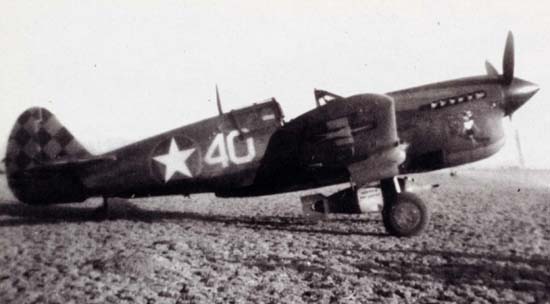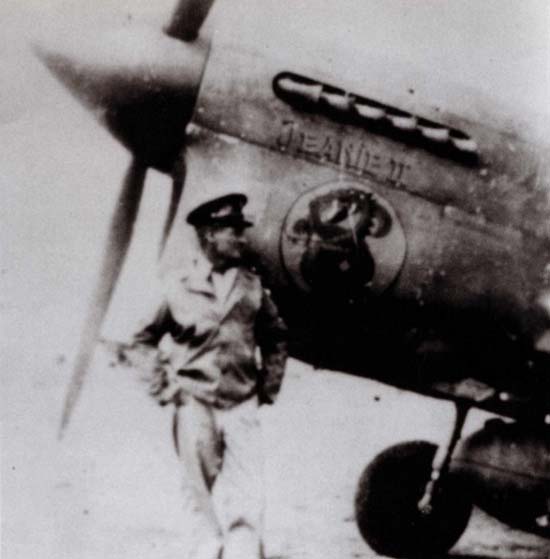|
HISTORY |
|
|
|
THE P-40 ERA (1942 - 1943) |
|
|
 |
|
PHOTO FROM " CHECKERTAILS" BY ERNEST R. McDOWELL |
|
318th FS Squadron Commander
Capt Joe Boomer's P-40 "Trixie" is pictured with a fire bomb constructed
from an fined drop tank with a hand grenade fuse.
|
|
|
|
Ready for combat, the
318th Fighter Squadron flew its first mission on 17 April 1943.
Twenty-two P-40s from the 318th and fourteen P-40's from the 319th FS
took off at 1645hrs (4:45 PM) to escort the
Martin B-26 Marauders of the
321st Bomb Group. The flight was attacked on their way to and over the
target, no bombers were lost, but the squadron did lose one of their
P-40s by enemy action. The pilot, Flight Officer Howard Cook bailed out
successfully after destroying a Luftwaffe Me-109, scoring the 318th
first victory and the first for the 325th FG. This was a great start of
a impressive string of successful escort missions for the 318th & 319th,
over the next 59 missions, the squadrons would not loose any of the
1,000 bombers escorted to enemy action.
|
|
|
|
During the first month,
the Group performed missions that had not been attempted in the P-40 in
the Mediterranean Theater. Warhawks of the squadron and the group were
the first to carry 500-pound bombs and did so repeatedly with success.
The group also experimented with other ordinances ranging from 20lb
fragmentation bombs to 1,000-pound high explosive bombs eventually using
them in selected missions. On 28 May 1943, the 318th performed what is
believed to be the longest P-40 mission over flown in the Mediterranean
Theater, lasting 3 hours covering 325 miles to reach their target,
Trapani/Milo Airdrome in Sicily.
|
|
|
|
Action of the 318th
against targets in North Africa lasted actually less than a month. At
the same time, missions were being flown against the
Mediterranean
Islands of Sardinia, Sicily
and Pantelleria. During this period, the Dragons established set a high
bar for other units flying the P-40, during mission flown to the
Islands, the squadron destroyed eight enemy aircraft. The unit had
performed every task assigned to it in an outstanding manner, never
losing a bomber due to enemy fighter action and accomplishing every
mission successfully and effectively. Mechanical maintenance by the end
of May was also excellent, with 97% of the squadron planes participating
in each mission completing the assignment.
|
|
|
|
On 2 June 1943, the
318th FS moved from Montesquieu to Souk-el-Khemis, Tunisia. This was a
temporary field to be occupied for only two weeks. Between 5 June and 11
June, operations were carried out exclusively against the Island of Pantelleria.
Green Dragon fighters flew as many as three missions a day during this
period and were highly instrumental in bringing about the surrender of
the island, the first enemy territory to be completely defeated by air
power alone. During the Pantelleria operations, the Group reached the 60
Mission milestones with 41 aerial victories, 11 losses in
1,341 sorties.
|
|
|
 |
|
PHOTO FROM " CHECKERTAILS" BY ERNEST R. McDOWELL |
|
P-40F "Jeanie II" was the
first aircraft to wear the 318ths "Green Dragon" unit insignia.
|
|
|
|
On 19 June 1943, the
unit received orders to move to northeast to Mateur. Conditions at
Souk-el-Khemis were very harsh, temperatures at the squadrons base
camping was almost unbearable, dust lingered over the treeless valley
for hours after a take-off of the squadrons aircraft, thousands of flies
were constantly in tents, the mess hall, and latrines contributing to a
large percentage of men suffering with diarrhea.
|
|
|
|
In mid 1943, the
Northwest African Air Force (NAAF) issued a request to all of its
fighter and bomber groups to design and apply unit specific
identification markings for their aircraft. This request by the NAAF was
to provide crews with a quick means of identifying a particular bomber
or fighter group during missions. Using the Checkerboard design of WWI
German ace Lt. Werner Voss as inspiration John Watkins of the 318th FS
and Maj. Bob Baseler of the 317th FS set out to create a similar design
for the aircraft of the 325th.
|
|
|
|
Concentrating on the
tails of the aircraft, the first design consisted of black and white 6"
square checks, and later red and white checks, which in aerial tests
appeared to be entirely red and with the black and white scheme,
appeared to resemble a Nazi Swastika at a quick glance. They next tried
black and yellow 14" square checks painted ninety degrees to the leading
edges of the vertical and horizontal tail surfaces, this design stayed
true at the longest distances. After review and approval from the 325ths
Group Commander Colonel Gordon H
Austin, a large conceptual drawing of the tail design was presented to
Major General Carl Spaatz, Commander of the NAAF by Lt. Watkins. General
Spaatz liked what he saw and approved the design, the first approved in
the NAAF - the Checkertail Clan was born! The Checker Tail would be used
on all of the Groups aircraft (including Group B-26 & B-25 "Hacks" or
utility aircraft) with 12" squares on P-47s, and 10" squares on P-51.
|
|
|
|
The new base at Mateur,
situated southwest of Lake Achkel, was separated from the lake by hill
"508" where fighting could be heard in the distance even after the
Germans officially surrendered in North Africa. Operations from Mateur
were focused solely on the Islands of Sardinia and
Sicily
and when the latter was invaded on 10 July 1943, the Green Dragons flew
intensive missions in support of the ground forces, attacks on gun
positions and airfields. This task was efficiently accomplished with
intercepting aircraft being blasted from the skies.
|
|
|
|
Since the 318th and the
other squadrons of the 325th killed all of the assigned targets by the
end of July, attention was turned towards the sole remaining target
within range of Sardinia Island. Attacks continued against this Island
until 22 September, with missions almost exclusively flown by squadrons
of the 325th Fighter Group. For this reason, the 318th claims a large
part in effecting its ultimate surrender. During July, the Group reached
the 100 Mission
milestone with 103 aerial victories, 31 losses in 2,747 sorties with the
pilots of the 325th averaging better than one victory per mission.
|
|
|
|
Command of the 318th
changed hands while Squadron was based at Mateur, with Captain James F.
Garrett replacing Captain Joseph A. Bloomer on 20 August 1943, becoming
the Squadrons third Commanding Officer in combat.
|
|
|
 |
|
PHOTO FROM " CHECKERTAILS" BY ERNEST R. McDOWELL |
|
A flight of 325th Fighter
Group P-40's are pictured during a mission in North Africa.
|
|
|
|
On the four month of
combat, Sicily fell to the Allies on 17 August 1943, during that period
of combat 110 missions, 3,233 sorties, downing 128 enemy aircraft while
only losing 34 of their own with a kill ratio (after a slow start) of 4
to 1. During the next few months, the 325th was the only single-engined
fighter group in the Northwest African Strategic Air Force (NASAF) and
with forces resisting on the Island of Sardinia, the Checkertail Clan
was given the task of ending fight.
|
|
|
|
The Commander of the
NASAF, the famed General Jimmy Doolittle, directed the 325th to fly
daily missions with the intent to kill enemy fighters, harass and/or
destroy their establishments and disrupt communications. Squadrons of
the Checkertail Clan bombed and strafed power stations, factories,
bridges, ships, air raid warning stations. In an effort to convince the
final elements of the Axis forces fighting on Sardinia, the Group
devised a plan to communicate a message attached a streamer Calling for
Italian leadership to surrender to the "Checkertail Warhawk Group" to a
bag with additional messages to place white crosses on their airfields
if they comply. A short time later, German forces began demolishing the
airfields and withdrawing their personnel and equipment, formally
surrendering two weeks later.
|
|
|
|
On 22 September 1943 a
flight of five P-40s from each squadron escorted, a USAAF C-47 with
Allied and Italian officials closed the chapter for the P-40s in 325th
service. All P-40's were transferred to the 324th Fighter Group, except
for a few that stayed with the Group for a short time to be used for
pilot proficiency purposes.
|
|
|
|
Final record for the
325th Fighter Group in the P-40:
- 128 missions
- 3,990 sorties
- 10,121:45 combat
hours
- 135 aerial victories
- 35 losses
- 328,820lbs of bombs
dropped.
|
|
|
|
Next page: The P-47 Era (1943 - 1944) |
|
|
|
|
 |